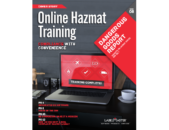This blog appears at the beginning of the week prior to the Christmas holiday. The Labelmaster family would like to take this time to wish all our clients, friends, and readers a very happy holiday and a safe and peaceful gathering time with those you treasure. Here’s the latest regulatory news, including major news about…
Infographic: Who needs Dangerous Goods training? And what kind?
Updated with three new training modules! Who needs Dangerous Goods training? That’s easy. Training is mandated by law for anyone involved in the transport of Dangerous Goods. There are very few exceptions to the rule. But who needs what kind of training? That’s a more complicated question. Employers are responsible for making sure every employee…
Dangerous Goods Report | Vol. 11
Summary: Volume 11 of the Dangerous Goods Report focuses on how today’s “I want it now” e-commerce consumer has forced every supply chain organization to rethink and re-engineer how they do business. How do Dangerous Goods professionals ensure compliance in the new decentralized, omnichannel e-commerce environment? Hazmat transport in today’s “get it tomorrow” world. How top…
Besides hazmat employees, who else should get hazmat training?
Every organization handling Dangerous Goods knows (or ought to know) that employees meeting the definition of a “hazmat employee” need to be trained in accordance with 49 CFR, Part 172, Subpart H, unless otherwise excepted. Who’s a hazmat employee? The short version of the definition, from Part 171.8, is: “A person who … directly affects…
Remember these disasters? “Dang Good” training made sure they never happened.
This post is adapted from a presentation given at the 2017 Dangerous Goods Symposium by Gene Sanders, founder and manager of W.E. Train Consulting. Since we can abbreviate the words “hazardous materials” to “hazmat,” I say we shorten “Dangerous Goods training” to “Dang Good training.” It saves time, and it describes what we trainers hope…
Dangerous Goods Report | Vol. 9
Summary: Volume 9 of the Dangerous Goods Report looks at an innovation that may change how we transport lithium batteries and battery devices, despite all the safety and regulatory hurdles involved. We also assess the unique challenges facing seven industries that ship Dangerous Goods, and review the eye-opening findings of our first-ever international DG compliance…
Dangerous Goods Report | Vol. 8
Summary: DG Training Online—Compliance with Convenience. Dangerous Goods trainers embrace interactive online training as a stress-reducing solution. Integrated DG Software = Streamlined Compliance. Why more of today’s hazmat shippers are integrating DG software with their ERPs. State of the Ion. A snapshot of current lithium battery shipping regulations, and the packaging breakthrough that may make battery shipping less…
Dangerous Goods Report | Vol. 7
Summary: HM-215: Are you ready for the border patrol? If you ship Dangerous Goods, don’t let new border measurement regulations for labels and placards catch you unprepared. Ship damaged batteries in a fiberboard box? Yes, you can! Just in time for the largest cell phone recall ever—new Special Permit Packaging makes reverse logistics easier and…
16 reasons to sign up for the 2016 Dangerous Goods Symposium now
The 2016 Dangerous Goods Symposium—a.k.a. DGS XI—is slated for September 7–9, at the Loews Chicago Hotel. As always, the Symposium will feature workshops and presentations from some of the sharpest trainers and practitioners in the Dangerous Goods galaxy, along with unparalleled networking and plenty of downtime pleasantries. DGS XI will only be free for…
Dangerous Goods Report | Vol. 5
Lithium Battery Shipping—Retail Rolls with the Changes. Cover Story: Challenging skies for lithium battery shippers. As lithium battery shipping regulations get even more complex and restrictive, retailers must adopt new processes and tactics. A look inside UN-certified packaging. Do you need it? Is it worth it? And what do all those letters and numbers mean?…
- 1
- 2









